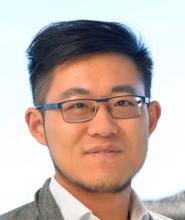Guosong Hong wins a Science & PINS Prize for Neuromodulation
Taylor Kubota
GUOSONG HONG, assistant professor of materials science and engineering, is the 2020 Science & PINS Prize for Neuromodulation finalist for his essay “Seeing the Sound.”
The prize, which has one grand prize and one finalist, is administered by Science and Science Translational Medicine. Winners are chosen based on essays describing outstanding neuromodulation research – research on modulating neural activity through physical stimulation of targeted sites in the nervous system – with implications for translational medicine. This year’s grand prize essay was written by Viviana Gradinaru, professor of neuroscience and biological engineering at California Institute of Technology. Both essays were published Aug. 7 in Science.
“I wanted to use this essay to convey to the general public how engineering can help biologists and medical researchers come up with new tools for understanding and treating life-threatening and severely debilitating diseases,” said Hong. “In addition, by this essay I aimed to encourage the awareness of multidisciplinary sciences in public, thereby improving the societal outcomes and making broader impacts of fundamental research at the intersection of engineering and neuroscience in my lab.”
Hong’s essay focuses on his research in sono-optogenetics, a technique where sound waves are applied to the body and converted to light to precisely modulate the activity of neurons. (The light emission controls neuron activity via ion channels that are sensitive to light.) Sono-optogenetics is less invasive than optogenetics – an existing technique for controlling neurons with light – because in sono-optogenetics the ultrasound has much deeper tissue penetration than light and is converted to light emission through interaction with special nanoparticles injected into the bloodstream. In contrast, optogenetics relies on the insertion of optical fibers to deliver light to the brain.
As a result of this reduced invasiveness, Hong has high hopes for the possibility of someday using sono-optogenetics in humans to address a wide variety of health issues.
“I envision sono-optogenetics will enable clinical translation of optogenetic neural modulation for treatment of a number of neurodegenerative and psychiatric diseases, such as epilepsy and Parkinson’s disease,” said Hong. “And this method can be extended broadly to any application that needs a light source deep in the body, including photodynamic therapies to treat cancer and viral infection (such as delivering UV and blue light for inactivating COVID-19 viruses), as well as light-induced in vivo genome editing with spatiotemporal precision.”
Currently, Hong’s lab is focused on developing what they refer to as a “light sculpting” method. This would make it possible to produce user-defined light emission patterns in any biological tissue in the body by combining materials development with acoustic engineering.
“This will offer unprecedented capabilities to control any light-induced physiological processes inside the body in a non-invasive manner,” said Hong.
